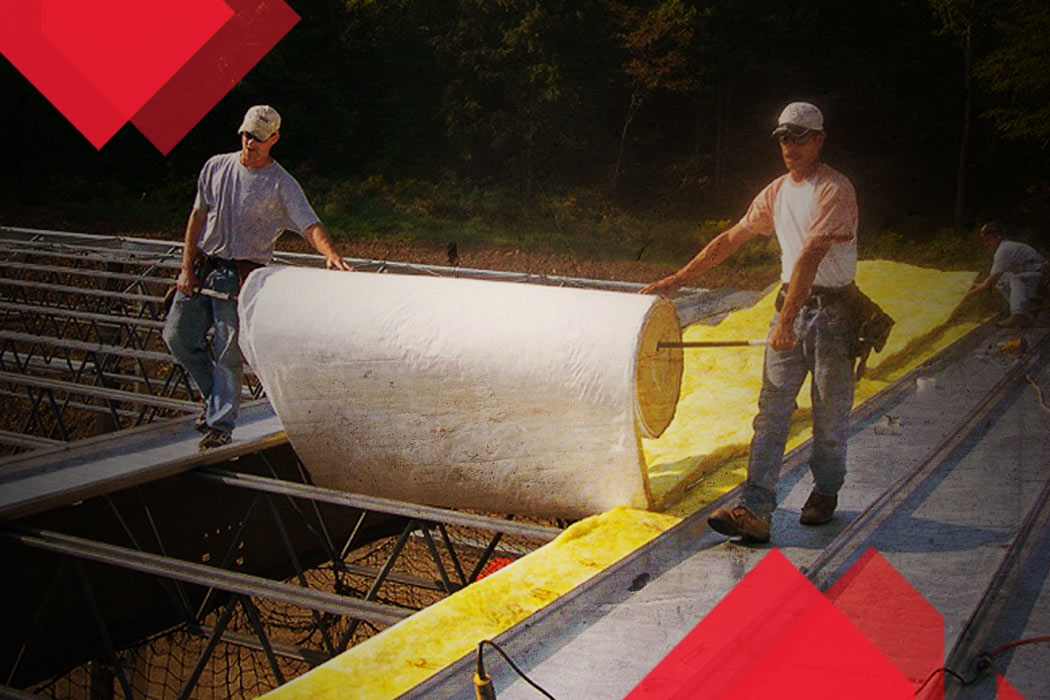February 27, 2015
by Star Building Systems

Testing has shown that fiberglass insulation that has gotten wet from rain or snow during installation may recover its full R-value if allowed to completely dry out and recover its original thickness. It is, however, difficult to ascertain whether or not the insulation has dried completely or if it has fully recovered its original thickness if it has gotten wet enough to compact.
It is crucial that there are no contaminants in the water that will contribute to mold or mildew growth. Thus, the fiberglass should recover its original R-value and be safe to use if:
Fiberglass insulation that has gotten wet from storm or floodwater should be removed and replaced, as these sources have a high probability of containing contaminants that support the growth of mold or mildew. Fiberglass metal building insulation must pass the mold growth test as specified in ASTM C991. Since there is no effective or practical method to determine compliance after insulation has gotten wet from flood or storm water, it is recommended that affected insulation be removed and replaced.
While most manufacturers do not recommend painting facing, it can be done in a few common cases. It is important to remember that, when facing is painted, its UL fire rating is no longer valid and the paint may potentially flake and fall off the facing over time. For more detailed information, including a guide on how to paint the exposed side of a vapor retarder, visit Lamtec’s website.
Is the condensation forming on a structural member of a building and/or on the facing of the roof and/or wall insulation? Or is it forming on the inside surface of a roof and/or wall panel behind the insulation?
Condensation that forms on a metal surface inside the building or on the interior side of the facing on the insulation is caused by the moisture that is dissolved in the air (water vapor) coming in contact with a surface that is at or below the condensation (dew) point. (The condensation point is dependent on relative humidity.) When water vapor comes in contact with something that is at or below the dew point, the vapor condenses at the point of contact and is seen as water in the liquid state. Condensation on the interior surface of a vapor retarder is evidence that the vapor retarder is relatively effective.
In other words, the water on the inside of the vapor retarder has not gotten through the retarder and into the fiberglass insulation, which would ultimately reduce the effectiveness of the insulation.
When condensation forms on the interior surface of a roof or wall panel, behind the insulation, the water vapor has either gotten through or around the vapor retardant facing and has then condensed on the inside surface of the wall or roof panel. Water vapor can get through a vapor retarder if the vapor pressure between the interior and the exterior of a building is too great or if a vapor retarder with an insufficient perm rating has been used. Water vapor can get around a vapor retardant facing wherever there are holes in the facing, where insulation splices have not been properly made, or where the facing has not been adequately sealed around necessary penetrations such plumbing and/or electrical fixtures.
A more relevant question would be, “what is the most realistic maximum length of faced insulation roll that I can purchase?” We have learned that we are capable of producing rolls much too large and heavy to be handled on a job site. We have had instances where people have stated that the long roll lengths they had asked for were too cumbersome to be practical in the field. Therefore, as a guide, consider that the most realistic maximum roll lengths would be for 2” thick, 300 linear feet (282 pounds); 3” thick, 270 linear feet (368 pounds); 4” thick, 240 linear feet (414 pounds); 5” thick, 225 linear feet (455 pounds); 6” thick, 210 linear feet (497 pounds); 8” thick, 140 linear feet (435 pounds); and 9” thick, 100 linear feet (425 pounds).
Standard roll widths of metal building insulation are 36”, 48”, 60”, and 72”.
72” is the widest insulation we laminate.
Standard metal building thicknesses are 2”, (R-7), 3.4” (R-10), 3.7” (R-11), 4.3” (R-13), 5.3” (R-16), 6.3” (R-19), 8.0” (R-25), and 9.25” (R-30). 9.25” (R-30) is the thickest metal building insulation that can be purchased. While Utility Blanket is available only in the 2” thickness, both Certified R and MBI Plus are available in the thicknesses mentioned above, with the exception of 2”.
In the past, the major manufacturers of metal building insulation posted and advertised the density of the fiberglass they produced. This is no longer done. The labels that manufacturers adhere to their rolls of insulation give the R-value, the thickness, the width, and the length of the product, but do not mention the density. That is because the density is now considered proprietary information due to the fact that the manufacturers adjust the density to achieve the desired R-value, which is what they sell: R-values. The resultant R-value that is posted on the label of the insulation is achieved by adjusting the density. The bottom line is that fiberglass manufacturers are not selling density and they are not selling thickness; they are selling R-value.
Have questions about metal building insulation? Head over to Therm-All’s MBI page.
Become part of the powerful Star network. We invest in builders who understand the value of results and provide support that develops strong relationships between you and the entire Star team.
Your building is the cornerstone of the community where people live, work and play. Find a local Star Authorized Builder and let us help you bring your vision to life.